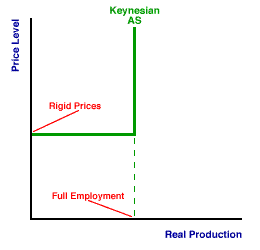
|
|
TECHNOLOGY, AGGREGATE SUPPLY DETERMINANT: One of several specific aggregate supply determinants assumed constant when the short-run and long-run aggregate supply curves are constructed, and that shifts both aggregate supply curves when it changes. An increase in technology causes an increase (rightward shift) of both aggregate supply curves. A decrease in technology causes a decrease (leftward shift) of both aggregate supply curves. Other notable aggregate supply determinants include wages, energy prices, and the capital stock. Technology comes under the resource quality aggregate supply determinant.
Visit the GLOSS*arama
|
|


|

|
                           KEYNESIAN AGGREGATE SUPPLY CURVE: An aggregate supply curve--a graphical representation of the relation between real production and the price level--that reflects the basic principles of Keynesian economics. The Keynesian aggregate supply curve actually comes in two versions. The basic version is reverse-L shaped, with a horizontal segment connected to a vertical segment at a sharp corner. The modified version is also reverse-L shaped, but the vertical and horizontal segments have positive slopes and connecting corner is rounded. An alternative is the classical aggregate supply curve. An aggregate supply curve is a graphical representation of the relation between real production and the price level. Keynesian economics implies that the aggregate supply curve contains two segments. One segment is more or less horizontal, indicating that price rigidity in the downward direction results in a reduction in real production. The other segment is more of less vertical, indicating that full employment is more or less maintained at higher price levels.| Keynesian AS Curve | 
|
The exhibit to the right illustrates a basic Keynesian aggregate supply (AS) curve. The obvious characteristic is that the curve is shaped like a reserve L, with a horizontal segment joining a vertical segment at a sharp corner. The horizontal segment of the curve reflects the Keynesian notion that a decline in demand leads to a decline in real production, primarily because prices remain constant. The vertical segment is a recognition that the total quantities of resources are fixed and that total production is ultimately limited, which results in full employment.While this reverse-L shaped curve captures the original essence of Keynesian economics, the Keynesian view has changed over the years. A more refined version of the Keynesian aggregate supply curve can be illustrated by clicking the [New Keynesian AS Curve] button. This new curve retains the same basic reverse-L shape, but the horizontal segment has a slight, positive slope rather than being perfectly horizontal and the vertical segment has a steep, positive slope rather than being perfectly vertical. Moreover, the vertical and horizontal segments are joined by a curved segment rather than a sharp corner. This version of the Keynesian aggregate supply curve is both more realistic and looks a great deal like the short-run aggregate supply curve used in modern aggregate market analysis.

Recommended Citation:KEYNESIAN AGGREGATE SUPPLY CURVE, AmosWEB Encyclonomic WEB*pedia, http://www.AmosWEB.com, AmosWEB LLC, 2000-2025. [Accessed: July 18, 2025].
Check Out These Related Terms... | | | | | | |
Or For A Little Background... | | | | | | | | | | |
And For Further Study... | | | | | | | | | | | |
Search Again?
Back to the WEB*pedia
|



|

|
BROWN PRAGMATOX
[What's This?]
Today, you are likely to spend a great deal of time browsing through a long list of dot com websites seeking to buy either a case of blank recordable DVDs or a pair of red goulashes with shiny buckles. Be on the lookout for mail order catalogs with hidden messages.
Your Complete Scope
This isn't me! What am I?
|

|
|
On a typical day, the United States Mint produces over $1 million worth of dimes.
|

|
|
"A winner is someone who recognizes his God-given talents, works his tail off to develop them into skills, and uses those skills to accomplish his goals. " -- Larry Bird, basketball player
|

|
JF
Journal of Finance
|

|
|
Tell us what you think about AmosWEB. Like what you see? Have suggestions for improvements? Let us know. Click the User Feedback link.
User Feedback
|


|


